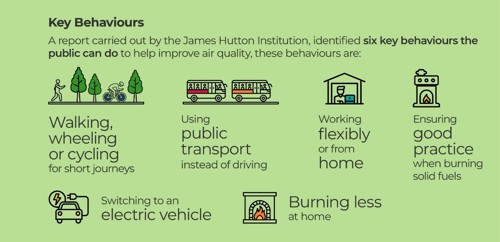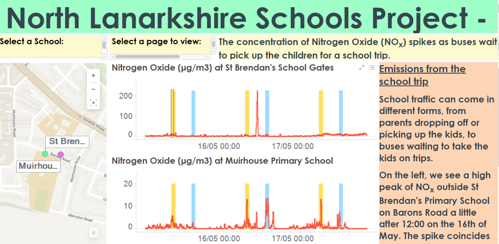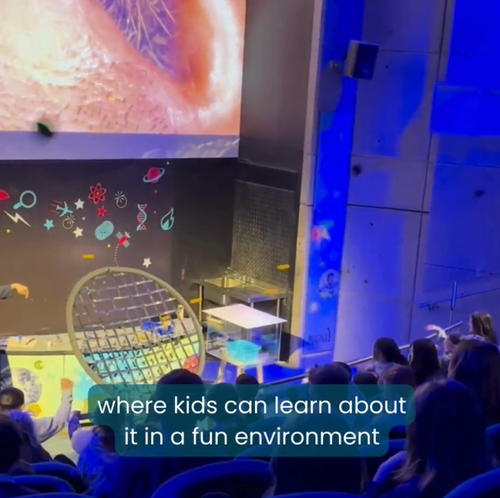We all contribute to air pollution through our daily activities. This section contains information on public engagement and how, if we increase individuals and communities’ knowledge of air quality, we can change behaviours and make positive changes for the environment.
The quality of our air is important to us all and we all have a part to play in maintaining good air quality and reducing our emissions. This section contains information on public engagement, citizen science projects and how, if we increase individuals and communities’ knowledge of air quality, we can change behaviours and make positive changes for the environment.
Key messages
- The quality of the air that we breathe is fundamental to the health of our people and planet. Air pollution places quality of life and our precious natural environment at both short and long-term risk.
- There may be a strong awareness of air quality and climate change issues in Scotland, but there are also likely to be significant barriers to engagement and behaviour change, particularly amongst deprived communities.
· Providing the public with information, raising awareness and behavioural change are all interlinked and crucial for the delivery of sustained change in environmental quality generally and air pollution specifically.
· Air quality behaviours are informed by many factors that need to be considered when designing meaningful and effective public engagement. This requires a variety of different approaches, using a range of materials to develop tailored multi-media campaigns.
Why is public engagement important?
The Air pollution and Air Quality page describes some of the main policy measures on air pollution (usually at national or local government level) which have been developed to help reduce emissions and protect human health and the environment. These often take time to develop, implement and provide measurable improvements in air quality.
We all, as individual citizens, can take immediate action to reduce both our contributions to emissions and our exposure to air pollution through making changes to our behaviours and choices in our day-to-day lives. As we will all have unique characteristics on how air pollution affects us and how we affect it, the data, information and guidance we receive needs to be tailored in a variety of formats, levels of understanding and accessibilities to allow us to make informed decisions on what we do and how we can change what we do.
There broadly appears to be good awareness of air quality and climate change issues in Scotland. There are, however, significant barriers to engagement and, importantly, behaviour change. Therefore, providing the public with the appropriate information, raising their awareness and fostering behavioural change are all inextricably linked and crucial for the delivery of sustained change in environmental quality generally, and air pollution specifically.
There are a variety of engagement approaches which can be used, either individually or in combination, with partner organisations working together to achieve shared goals. These approaches can be designed specifically for the target audience to be meaningful and productive. The results of the work can also be monitored and evaluated to be able to identify their effectiveness, feedback to participants and then develop appropriate follow-up initiatives.
The Scottish Government’s Cleaner Air for Scotland 2 (CAFS2) strategy identifies some of the approaches which can be used and have been suggested for use in Scotland and these include:
- Consider taking a holistic approach that reflects citizens’ lived experiences rather than focusing exclusively on air quality issues.
- Ensure engagement approaches are inclusive of all sectors of society and appropriately communicated (and also target specific groups separately where necessary).
- Gain support from, and include, a range of partners with shared interests.
- Support citizen-led engagement events and activities, e.g. citizen science projects, citizen’s panels.
- Use change agents, influencers and middle actors to help raise awareness and promote behaviour change to affect behaviours.
- Use social media to spread awareness through wider social connections and families.
Much of the Scottish Government’s focus in this area has been on taking steps to help development a public engagement framework for air quality, which is a key action in CAFS2. The Scottish Government commissioned the James Hutton Institute (JHI) to review evidence around the key actions people can take to help improve air quality in Scotland. The Key Behaviours Report identifies six key behaviours that individuals can take for air quality improvement. From thinking about how we get around whether that’s walking, wheeling or cycling for short journeys or using public transport instead of driving, looking at opportunities to work flexibly or from home and looking at how we heat our homes. This work will form the basis of the public engagement framework for air quality in Scotland.

Six key behaviours to help improve air quality – James Hutton Institute (JHI).
As we gain more experience in the field of public engagement and air pollution, we will be able to develop our approach and build upon our learning experiences. More research is still needed to provide clear evidence on levels of citizens’ knowledge, attitudes, and concerns related to air pollution, as well as on willingness to change behaviours and to avoid providing complex, confusing or conflicting messages.
Working with partners
Public engagement on air quality can take place at a variety of levels, involving a variety of partners using a variety of techniques. Here are examples of some of the work which has been carried and show the different types of engagement which have been used. More detail on specific projects is available on the page on Air Quality Projects.
Internationally
CleanAir@School was a joint initiative between the European Environment Agency (EEA) and European regulators (Environmental Protection Agencies – EPAs) launched in Dublin in April 2018 and ran until mid-2020. Under the initiative individual citizens, schools, local authorities and EPAs monitored air quality around schools across eight European countries in 2018 and 2019 using common approaches and then investigated and reported on some of the techniques used to communicate the data and how behaviours were changed.
The participating EPAs engaged with local communities and explained how they worked to improve air quality and some of the solutions which could help reduce levels of air pollution. The Scottish Environment Protection Agency (SEPA) was a key participant in this project, and praised for the approach they had taken, and the project results and report are available on-line.
Nationally
Since 2017 the UK’s Clean Air Day is held annually on the third Thursday in June and aims to inspire active participation, encourage individual behaviour change and use a collective voice to call for, and support, system-wide positive changes to improve air quality. Clean Air Day helps to drive a positive shift in public knowledge and action, is a chance to find out more about air pollution, share information, and take steps reduce air pollution and improve our environment.
Clean Air Day in Scotland is supported by the Scottish Government and takes the form of events (both in-person and online) to share information about air pollution, health, the environment, and the positive steps people can take to reduce their contribution to emissions and exposure to poor air quality. To support the day, partners also run a media campaign to highlight the key messages, the events which are taking place and the positive work being carried out to reduce air pollution across the country.


Key themes from Clean Air Day 2024 – The Scottish Government
Local authorities and schools
Advances in air pollution sensor technology and wider use of mobile electronic equipment are leading to an increase in our ability to gather relevant environmental and positional data which can be used for specific public engagement, education and citizen science projects. This allows us to provide local data on air pollution which is directly relevant to participants and can start the discussion on sources of air pollution and measures to improve air quality.
Local authorities and SEPA work with schools who are interested in learning about air pollution by providing them with access to low-cost monitoring sensors which provide local data to the school, and which can then be turned into teaching materials and used to drive classroom lessons and discussions about air pollution and some of the activities that contribute to poor air quality.
The low-cost monitoring equipment is fitted (usually for a few weeks) at locations around the school where interesting air quality data is likely to be recorded (such as pupil drop-off/pick-up areas, local access roads and bus stops). As the data is recorded, emission trends can be identified which can then be turned into information and then given to the schools for teaching exercises.

Data showing impacts on air quality associated with travel from a school trip – SEPA
Lessons can be structured around the data or other related topics such as climate change, the local environment, health and wellbeing and active travel and this can be combined with practical exercises, experiments, field trips and family-based activities. This type of work demonstrates how collaborative working between authorities, SEPA and schools can gain improvements in air quality while also achieving multiple benefits for people’s health and the local environment.
Educating about air pollution and air quality
Teaching pupils about air pollution, air quality and the steps they and their families can take to reduce emissions is an extremely important aspect of public engagement. A variety of techniques can be used from directed learning specifically in relation to air pollution, use of on-line teaching packages, linking into other school initiatives (such as active travel, cycling proficiency, wider local environmental projects) and participating in campaigns (such as Clean Air Day).
Classroom learning
In 2015, SEPA developed teaching material for air pollution and air quality aimed at primary and secondary schools (www.learnaboutair.com). The online teaching resource is available for free and provides learning materials around which classroom work can be structured and make pupils think about potential local sources, how we all contribute to air pollution through our own activities and to allow them to think about what actions they could do to reduce their own contributions or what actions they can implement around their school to reduce emission sources.
As part of this teaching package, each school that participates is invited to run a poster competition to promote solutions to air pollution, climate change or local environmental problems which could include aspects such active travel, anti-idling, health campaigns. The winning entries from each school are then made into a weatherproof banner which can be displayed at the school gates.

Pupils showing winning their winning banners – St Mungo’s Primary School, Glasgow
Exhibitions for public spaces
In 2017, SEPA launched a three-year educational exhibit at the Glasgow Science Centre. The exhibit was commissioned by the Scottish Government as part of the original CAFS strategy and was designed to help visitors discover the different sources of air pollution and how poor air quality affects our health and the environment. Following on from the success of the permanent exhibit, the Glasgow Science Centre have built a mobile air quality exhibit which incorporated the Place Standard tool for air quality. The mobile exhibit has already been to events and public spaces in Aberdeen, Glasgow and Edinburgh, and has been part of the Stirling Science Festival and to help launch the Stirlingshire Air Quality Villages Project.


Mobile air quality exhibit – Glasgow Science Centre
The mobile exhibit encourages visitors of all ages to think about their local environment and the quality of the air, how poor air quality can affect them and their family, how the design of the places where we live and work can influence how we create and are exposed to air pollution, and how we can all help to improve air quality through daily choices.
Glasgow Science Centre Learning Lab – Our Amazing Air
During 2022 SEPA commissioned the Glasgow Science Centre to develop and deliver an eight-week learning programme for pupils to raise awareness of air pollution and some of the steps we all can take to have a positive impact on air quality.
The Learning Lab programme called “Our Amazing Air” is intended to deliver a learning programme for P5 – P7 pupils supporting learners to investigate what air is and why it is so important for us, what air pollution is and how we monitor it, how air quality can be improved and some of the steps we all can take to have a positive impact on air quality and the environment.
The programme includes a variety of materials and support for teachers including teacher training sessions, detailed lesson plans with Curriculum for Excellence (CfE) experiences and outcomes, pupil worksheets, video content, family learning activities, question and answer sessions with professionals in the field and a visit to Glasgow Science Centre. The teaching session also culminates with resources and events to coincide with the annual Clean Air Day and is available for every primary school in Scotland. A total of 1200 pupils from 50 classes took part during the 2024 term.

Science show at Glasgow Science Centre on Clean Air Day (and running throughout summer 2024) – SEPA
The UK’s 8th annual Clean Air Day, ran on Thursday June 20th 2024, and SEPA supported a day of learning at the Glasgow Science Centre where young people were encouraged to lead change, tackle air pollution and protect the future of our environment through science.
More than 300 pupils were invited to the event to celebrate the schools that have taken part in the Our Amazing Air learning lab programme. The event offered a range of activities centred around air quality, including interactive experiments, talks with our air quality experts, and an exhibition and science show, which will continued to run during the summer holidays and was open to all visitors.
More information on public engagement can be found on the Air Quality projects page.
This page was added on 04 Oct 2024
Adobe Acrobat Reader is the free, trusted leader for reliably viewing, annotating and signing PDFs.
Download Adobe Acrobat Reader








